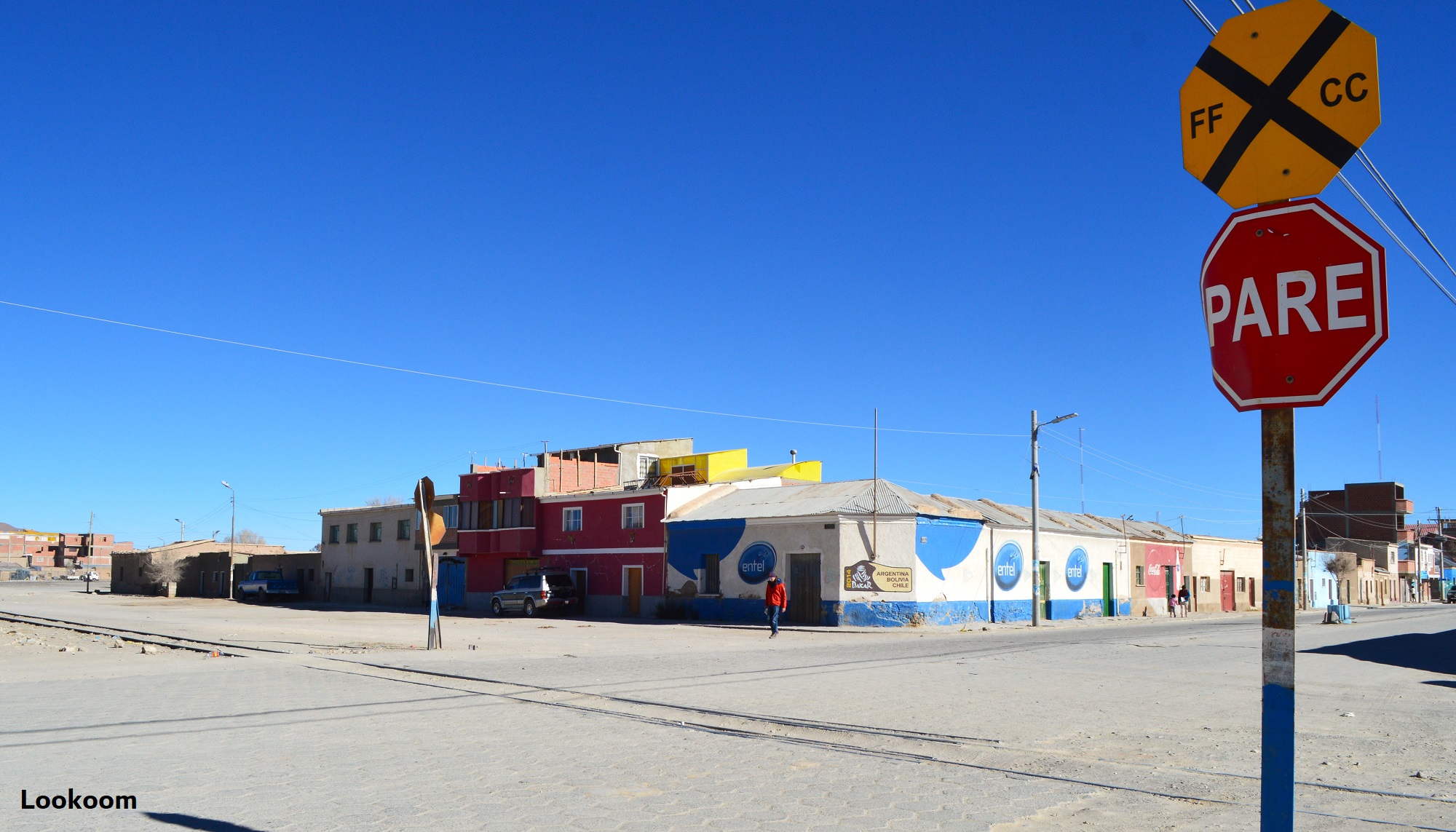(continuer en français) – Last updated: November 3, 2023

Tiwanaku is located in Bolivia, about 37 miles, 60 kilometres, from La Paz, on the way to Lake Titicaca and Peru. It was the political and religious centre of the Aymara people which developed over several centuries, exercising its influence over a vast region from the south of present-day Peru to the north of Chile.
It is not the most spectacular archaeological site in South America, with few surviving ruins, which makes it difficult to interpret and fails to capture the imagination, except for its mysteries. However, this site highlights a pre-Inca culture that reached a high level of organisation, allowing for example a real mastering of monumental architecture, qualities that the Incas would inherit and perfect.
The Bolivian village of Tiahuanaco extends to the limits of the historic site, with the former station of an abandoned railway serving as a ticket office.
When arriving on the site, the visit starts with two covered structures. Unfortunately photos are not allowed inside. The first one contains mainly the Bennett monolith, named after the archaeologist who discovered it in 1932. It is more than 24 feet, 7 meters, high and weighs 19 tons, the most massive of the monoliths discovered so far in Tiwanaku. It is richly ornamented, without all the symbolism being clearly identified.
The second building contains an exhibition of the objects found in the excavations, trying to retrace the history and familiarise visitors with what is already known about this ancient city.
The ceremonial centre was dominated by the Akapana pyramid, made up of seven successive terraces. The retaining walls are only partially reconstructed, leaving a shapeless structure resembling a vague mound of earth.
At the foot of the pyramid lies the Kalasasaya temple, a large platform that must have belonged to a religious complex surrounded by walls. These walls have partially disappeared, and what remains is the part supporting the terrace, containing solid monoliths arranged at regular distances.
On the sides, a series of small structures could have been mausoleums where mummies were placed.
In this probably sacred enclosure, two monoliths still stand where they were discovered.
The Fraile monolith is 10 feet, 3 metres, high and is located in the temple enclosure. However, its role and meaning remain uncertain. Its belt representing crabs seems to reinforce the hypothesis that Lake Titicaca, now 12 miles, 20 kilometres, away, was closer.
The Ponce Monolith was also found on the temple platform, although it is not clear whether this was its original position or what role it played. Each monument seems to be a new enigma.
The Sun Gate is one of the most publicized monuments of the site. It is made of a single block of stone weighing more than 10 tons, whose origin is traced to 62 miles, 100 kilometres away, on the other side of the Titicaca lake. Whether it was a symbolic gate or part of a real enclosure remains to confirmed
At the other end is another monumental gate, designated by symmetry as the Moon Gate. It has been reconstructed in the middle of the wall still in place. From here, a majestic staircase leads to the Semi-Subterranean Temple.
The Semi-Subterranean Temple is a kind of basin dug in the backyard of the temple platform. Although it is difficult to imagine the exact layout of the original site, it is clear that it was a place that received special attention, the walls being decorated with faces in relief creating a striking effect. Here again, the interpretation of the first archaeologists is based on many unknowns, their real meaning remaining mysterious.
Near the main site but outside the enclosure is the pyramid of Pumapunku. Its lower terraces can still be seen, as well as the interior drains allowing the evacuation of rainwater, maybe they were fountains descending from one terrace to the other.
The pyramid is surrounded by scattered vestiges that look like the pre-constructed elements of monuments to be assembled. The geometric shapes are clearly visible, although the decoration is rather basic.
The archaeological site of Tiwanaku is far from having delivered all its mysteries. It is certainly linked to the Peruvian site of Sillustani, about 62 miles, 100 kilometres away. Tiwanaku has been a UNESCO World Heritage Site since 2000.
To be informed of upcoming articles, register here (it’s free!).
Articles about Bolivia:
…

La Paz: Top 10
Strangely enough, La Paz is the administrative capital of Bolivia, where the national government has settled, while Sucre remains the official capital designated by the Constitution.
Sucre : Top 10
Since the civil war at the end of the 19th century political power has been based in La Paz, preserving Sucre from the excesses of change.


Sucre, Casa de la Libertad
It was there that on August 6, 1825 Independence and the Republic were proclaimed.
Potosi
The mines of silver, but also tin and zinc explain the existence of a city at more than 13.400 feet, 4.000 meters, of altitude.


Silver mines of Potosi
A visit to the silver mines is a must during a stay in Potosi.
The Tiwanaku mysteries
The site highlights a pre-Inca culture that reached a high level of organisation, qualities that the Incas would inherit and perfect.


The streets of Uyuni
At an altitude of over 11,800 feet, 3,600 metres, Uyuni attracts many visitors to Bolivia, not for the town itself, but as a starting point to travel the Salar de Uyuni and the South Lipez region.
Salar de Uyuni
A geological curiosity, the Salar of Uyuni is a tourist attraction that draws many travellers. It is located at an altitude of 11,800 feet, 3,600 metres, in southern Bolivia.

To be informed of upcoming articles, register here (it’s free!).


























Ah, incredible sculptures and a handsome, arid landscape. Take me there now!
LikeLiked by 1 person
Without being truly hostile, the landscape is quite exotic and contributes to the feeling of experiencing something different.
LikeLiked by 1 person
It’s quite impressive how these ruins have survived the test of time. It’s too bad that there are so many unknowns or mysteries around the various monoliths, gates and other structures.
LikeLiked by 1 person
Some of the unknowns come from the looting of the ruins to build other buildings, and not only churches as some say, but also simple enclosures for livestock. Now the fact that not everything is explained leaves room for imagination.
LikeLiked by 1 person
Looks a fascinating place to visit with teasing and incomplete glimpses of the life of an ancient civilisation
LikeLiked by 1 person
You have the right word, it is teasing to try to understand how this culture could develop and build such monuments.
LikeLiked by 1 person
So neat… I’m learning so much about S America!
LikeLiked by 1 person
Thanks for reading. Latin America certainly has a great supply of amazing sites.
LikeLiked by 1 person
even from ruins you can see a certain kind of genius to the design, systems for plumbing and the like. and the statues are amazing
LikeLiked by 1 person
It is quite astonishing that such a civilisation reached this level of sophistication on its own in a few centuries, only to disappear, replaced by the Incas, who were themselves defeated by the Spaniards.
LikeLike
So interesting that the Fraile monolith has a crab belt. I guess 20 km would have been a long way back then, so the hypothesis that the lake was bigger/closer at that time makes sense.
LikeLiked by 1 person
There is so little reliable information that everything is a mystery. At the same time it leaves room for the imagination to fill in whatever is missing.
LikeLiked by 1 person